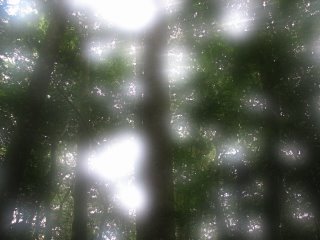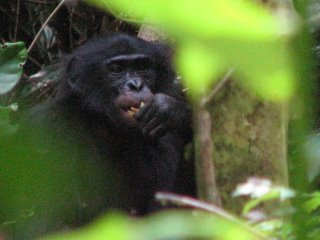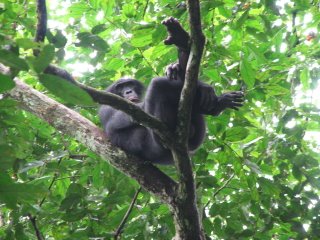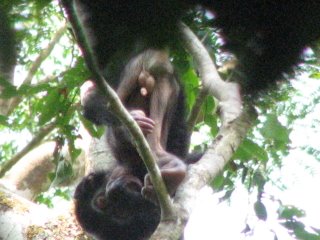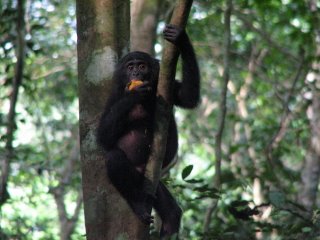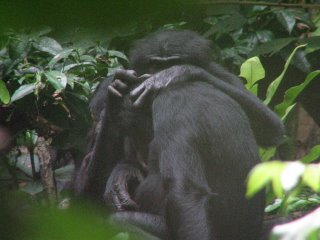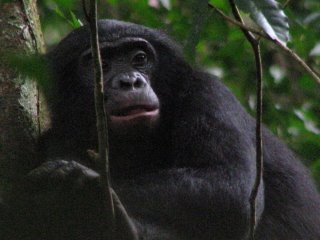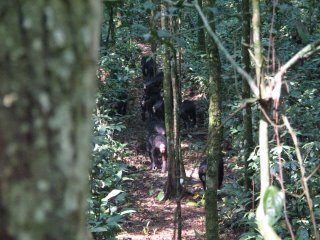Out of the darkness of the night on the vast Congo River the lights of Mbandaka finally came through late yesterday evening. We were approaching what now to me looked like a huge and modern town. After more than three months at Kokolopori, way up stream along the Congo and its tributaries, Mbandaka, this fairly run-down place by any Western standards, was the first point of contact with regular shopping opportunities, beds with pillows, a dripping but adequate shower, and most importantly Internet and emails. Little things but when for three months you don’t get them you can’t help but appreciate them more than you did before.
It’s now Tuesday, the 9th of January. We left the ‘port’ of Kokolopori at around 11 am or so on Friday. It was a fairly dramatic exit, in more ways than one. It is now the dry season and the level of the rivers had dropped significantly. What this means in practical terms and navigating our vessel through the narrow Maringa (also known locally as Luo) river, was a tricky thing to do. Within less than 5 minutes of push off we crashed head on into a thicket of thorny vegetation, growing on the bank. What followed shortly later, downstream from the site of the first crash, was even more extreme. Stressful for some, exciting for others, and painful for our cook, Landrine, who got hit on the head by a tree bough which ripped though and over the right side of the boats. People overboard frantically trying to ease the boats through the tree trap into which we crashed, chainsaw cutting though trees, and all the navigational skills of Le Blanc, the ‘captain’ of the boat, was what it took to get us through this very first stage of the journey back downstream to Mbandaka and the world of refrigerated drinks.
Three guys from Australia – a mix of lawyers, doctors and surfers (or something along those lines), Michael Hurley (the other half of Sally Coxe of the Bonobo Conservation Initiative), the BCI crew, a Congolese researcher, some hitch-hikers, and I were now drifting down the rivers. Amazing misty mornings, absolutely stunning sunsets in the evenings and lots of heat in between. Birds flying around – from one tree to another, darting above the water, just perching on trees at the edge. People, on pirogues, and in settlements along the banks – initially few and far between, but then more and more, the closer we were getting to Mbandaka. Every morning the coals in the boat’s ‘kitchen space’ would be dead. To start the fire anew and make hot water and breakfast we would usually come ashore at one of the small settlements (fishing camps) that we would otherwise drift by. The people there are nice enough and let us have some hot functioning coals. These morning stops along the way also provided us with some basic restroom facilities (a log in the bushes, which people squat on and deposit their digestive waste off its side).At one of these places we also bought a gigantic fish. No idea what it was called but I think it was delicious.
Before this calm drifting journey, there was a lot that went on during October, November and December. Establishing a research camp in the forest of the Hali-Hali bonobos Nsondo Camp was one of the first things I had to do on arrival at Kokolopori. By the way the English translation is Camp Leech (Nsondo = leech, the name of the stream, next to which the camp is situated).
From Nsondo camp the trackers and I followed the bonobos. In one word: amazing. Once I am back in the US, watch out for a special update of the blog with notes and copious amounts of pictures from the field.
Right now I have to think about re-packing all my luggage and preparing for the next leg of the return journey – the flight from Mbandaka to Kinshasa.
